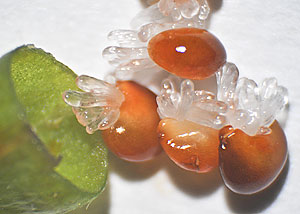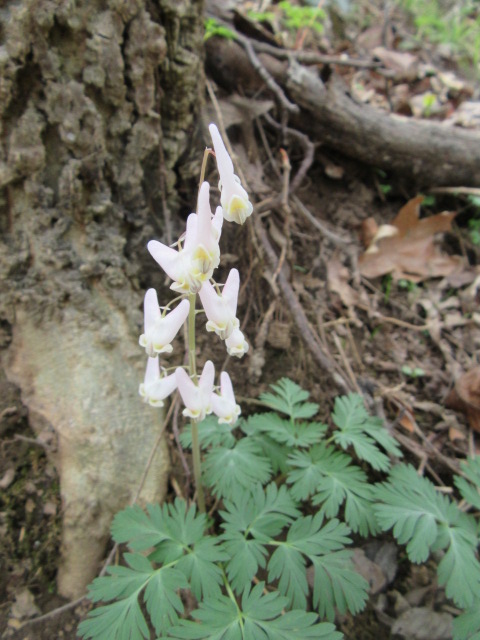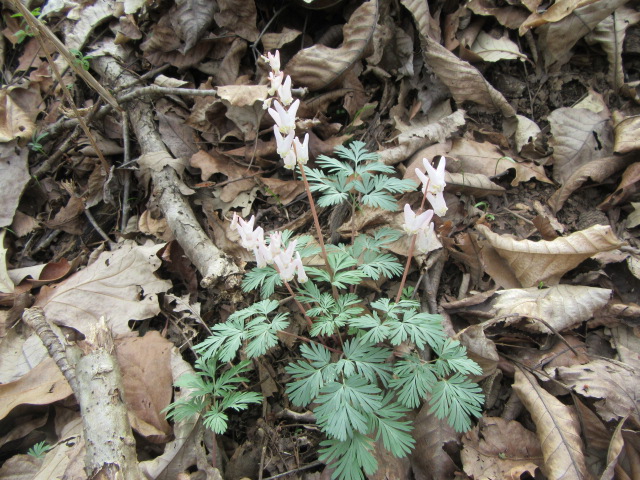
Dicentra cucullaria (Dutchman’s Breeches) on 4-20-22, #870-17.
Dutchman’s Breeches, Butterfly Banners, Kitten Breeches, White Hearts
Dicentra cucullaria
dy-SEN-truh kuk-yoo-LAIR-ee-uh
Synonyms of Dicentra cucullaria (19) (Updated on 12-21-23 from Plants of the World Online): Bicuculla cucullaria (L.) Millsp. (1892), Bicuculla occidentalis Rydb. (1902), Bikukulla cucullaria (L.) Millsp. (1892), Capnorchis cucullaria (L.) Planch. (1853), Capnorchis occidentalis (Rydb.) House (1922), Corydalis bracteosa (DC.) Spreng. (1826), Corydalis cucullaria (L.) Pers. (1806), Cucularia bulbosa Raf. (1808), Dicentra cucullaria var. occidentalis (Rydb.) M.Peck (1941), Dicentra cucullaria f. purpuritincta Eames (1931), Dicentra occidentalis (Rydb.) Fedde (1912), Diclytra bracteosa DC. (1821), Diclytra cucullaria (L.) DC. (1821), Diclytra cucullaria var. divaricata DC. (1821), Dielytra bracteosa (DC.) G.Don (1831), Dielytra cucullaria (L.) G.Don (1831), Fumaria bicalcarata Stokes (1812), Fumaria cucullaria L. (1753), Fumaria pallida Salisb. (1796)
Dicentra cucullaria (L.) Bernh. is the accepted scientific name for this species. Both the genus and species were named and described as such by Johann Jakob Bernhardi in Linnaea in 1833. It was first named and described as Fumaria cucullaria by Carl von Linnaeus in the second volume of the first edition of Species Plantarum in 1753.
As of 12-21-23 when this page was last updated, Plants of the World Online lists 8 species in the Dicentra genus. It is a member of the plant family Papaveraceae with 46 genera. Those numbers could change as updates are made on POWO.

Distribution map of Dicentra cucullaria from Plants of the World Online. Facilitated by the Royal Botanic Gardens, Kew. Published on the Internet; http://www.plantsoftheworldonline.org/. Retrieved on May 7, 2022.
The above distribution map for Dicentra cucullaria is from Plants of the World Online. Areas in green are where the species is native. The map on the USDA Plants Database is the same.
The map on iNaturalist shows where members have made observations. Anyone can join and it is a great website to confirm and share your observations. The maps on iNaturalist are continually updated as members post new observations.
THERE ARE SEVERAL LINKS AT THE BOTTOM OF THE PAGE FOR FURTHER READING AND TO HELP WITH A POSITIVE ID.

Dicentra cucullaria (Dutchman’s Breeches) on 4-20-22, #870-18.
Hello everyone! I was walking in a friend’s secluded woods on April 23 in 2020 when I ran across my first Dicentra cucullaria (Dutchman’s Breeches) (see photos at the bottom of the page). I was literally walking in the creek when I spotted a single plant and it didn’t have any flowers. The plant was growing on a steep hillside and I had to get on my hands and knees to get to it and take photos. My plans were to keep going back until it bloomed, but after a few days, we had a big thunderstorm. I went to the location and found there had been a landslide and all I could find was a single leaf sticking up through the mud. I went back to the woods in 2021 but couldn’t find a single Dutchman’s Breeches.
2022 was a different story. There were A LOT here and there along the creek. Not only that, but in 2020 I also found a single Cardamine concatenata (Cut-Leaved Toothwort) that I couldn’t find in 2021. There were LOADS in 2022… I have identified A LOT of species of wildflowers in his woods (and on his farm in general) that I don’t have here.

Dicentra cucullaria (Dutchman’s Breeches) on 4-20-22, #870-19.
Dicentra cucullaria is a rhizomatous perennial in the plant family Papaveraceae. It is a common springtime woodland plant throughout most of Missouri. It can be found in the midwest United States from North Dakota down to Oklahoma, eastward to South Carolina, and north into Canada. It is also been reported in Washington, Oregon, and Idaho. Plants are easily identified by their lacy leaves and unusual flowers which have spreading bluntly pointed spurs and underground rhizomes.
Plants prefer growing in light shade dappled with sun shining through trees before leaves fully come out and full shade. They like moist conditions along slopes next to streams and bluffs in fertile loamy soil with plenty of organic matter.

The above photo of Dicentra cucullaria rhizomes and bulbils was taken by Gerrit Davidse on March 25, 2007, and published on the Tropicos and Flora of Missouri websites. Tropicos is published on the internet at https://www.tropicos.org/home. This photo was retrieved on March 5, 2024.
The above photo shows the rhizomes and bulbils of Dicentra cucullaria. Each mature rhizome produces either a single leaf or flowering stem. New bulbils grow along the mature rhizomes and do not produce leaves or stems…
The above photo is from the Tropicos website on their Dicentra cucullaria page and it, along with many others, are also published on the Flora of Missouri website. Both websites and Missouri Plants are published by the Missouri Botanical Garden. Photos are available for use for non-commercial educational purposes.

Dicentra cucullaria (Dutchman’s Breeches) on 4-20-22, #870-21.
The grayish-green leaves arise from rhizomes on long petioles (3 1/8-9 1/2” long).

Dicentra cucullaria (Dutchman’s Breeches) on 4-23-20, #690-37.
Leaves are 4 times compound, divided into three primary leaflets which are divided into three secondary leaflets. The leaves are ovate to broadly triangular in outline, leaflets deeply cut into linear to oblanceolate lobes giving them a lacy, fern-like appearance. The undersurface (abaxial) is a lighter green than the upper surface (adaxial). The petioles can be light green to reddish in color.

Dicentra cucullaria (Dutchman’s Breeches) on 4-20-22, #870-25.
Racemes of 3 to 15 flowers arise from the rhizome on arching 4-14” long peduncles (flowering stem). Each flower is attached to the peduncle by a 1/4” long pedicle (flower stem). There is a pair of small bracts in the center of the pedicles.

Dicentra cucullaria (Dutchman’s Breeches) on 4-20-22, #870-26.
The neat flowers speak for themselves, although you may not understand what they are saying. I have seen some odd flowers, but Dutchman’s Breeches are close to the top of the list. I’ll give writing a description a shot, but there are links below that do a much better job.

Photo of Dicentra cucullaria taken by Gerald D. Carr on 3-28-07 and published on the Oregon Flora Image Project. Oregon Flora Image Project is published on the internet at: http://www.botany.hawaii.edu/faculty/carr/ofp/ofp_index.htm. The site is hosted by the Oregon State University. Retrieved on March 5, 2024.
So, let’s start at the top, rather the bottom since they hang upside-down… I really need to examine the flowers more closely, but I’ll give it a shot. From the pedicel (flower stem) is a pair of triangular-shaped sepals that are “normally” against the corolla. However, the above photo from the Oregon Flora Image Project shows them doing something else… Sepals can be white or have pinkish markings. Then there is the inflated corolla with two spreading outer petals that arch upward forming two spurs, then dropping downward (which would be upward if the flowers weren’t upside-down) and inward and join together tightly and form two curved wings. The wings are first downward, but curve upward when fully open. Some sites may say the curved wings are part of the inner petals, but that doesn’t make sense… OH, the corollas can be white or pink, and the sepals “should be” the same color or have have pinkish markings… I haven’t seen pink flowers in person…
Now for the inner petals… The tip (wings) of the inner petals are hidden until the wings of the outer petals curl upward. The inner petal is kind of tubular shaped and extends from the base of the flower (pedicel end) and a little beyond the outer petals at the tip. Most of the inner petals are hidden by the outer petals… The long inner petals tightly surround two stamens and a pistil with a 4-lobed stigma at the tip.

The above photo of Dicentra cucullaria nectaries is from the Iowa Plants website. Iowa Plants is published on the internet at http://www.iowaplants.com/index.html. Photo retrieved on March 6, 2024.
I almost forgot to mention the nectaries that are located in the spur of the outer petals. One very reliable site says the nectaries are located at the base of the flowers (pedicel end) between the inner and outer petals… Some bees chew holes in the spurs to get to the nectar, and even crawl inside.
I really need to dissect a flower, if they are plentiful, and have a closer look. The Iowa Plants website has a lot of great close-ups showing flower parts and one photo clearly shows the nectary located in the spurs…
Flowers are pollinated by bumblebees that can separate the petals to feed on the pollen. Flowers are cross-pollinated as the bees move from flower to flower. Butterflies and smaller bees (that chew holes in the spurs) feed on the nectar, but don’t assist with pollination.

The above photo of Dicentra cucullaria fruit is from the Missouri Plants website. Missouri Plants is published on the internet at http://www.missouriplants.com/index.html. Photo used by permission and retrieved on March 4, 2024.
Once pollinated, the flowers are replaced by inflated seed capsules that are tapered at both ends with the bracts still intact. Once dried, the capsules split (dehiscent) into two segments to release the seed.
The Missouri Plants website has been my number-one source for wildflower ID for many years. They have great photos and descriptions of many species found throughout Missouri. The site also has a glossary that has been quite helpful. Click HERE to view their page for Dicentra cucullaria.

The above photo of Dicentra cucullaria seeds and elaiosomes is from the Iowa Plants website. Iowa Plants is published on the internet at http://www.iowaplants.com/index.html. Photo retrieved on March 5, 2024.
Inside the capsule, the shiny black seeds (when mature) have white masses of elaiosomes that are attached at the notch.
Dicentra cucullaria is one of around 3,000 species of plants that use ants to disperse their seeds (myrmecochory). Ants take the seed into their nests and feed on the elaiosomes, then move the seeds to a waste area where the seeds germinate. Dried seeds will not germinate…
Iowa Plants is a great website that covers species found in the tall grass prairie region in Southeast Iowa. The site provides great photographs, some of which are highly detailed close-ups showing plant parts. I have learned a lot from the photos on this site! There are more descriptive photos of Dicentra cucullaria on the site which you can see by clicking HERE. Photos can be used for educational and scientific purposes with proper captioning.
HOPEFULLY, I can go back to the woods on my friend’s farm in 2024 and find the Dicentra cucullaria in abundance and doing well. I need more photos, especially close-ups, to replace those I have borrowed. Practice makes perfect! Hmmm… I also want to have a closer look at the inside of the flowers but I won’t destroy one unless there are a lot of flowers…
There are more photos at the bottom of the page…
I have enjoyed photographing and learning about the many wildflowers growing on the family farm and in other areas nearby. The farm is in Windsor, Missouri in Pettis County (Henry County is across the street, and Benton and Johnson aren’t far away). I have grown over 500 different plants and identified over 250 species of wildflowers (most have pages listed on the right side of the page). I am not an expert, botanist, or horticulturalist. I just like growing, photographing, and writing about my experience. I rely on several websites for ID and a few horticulturalists I contact if I cannot figure them out. Wildflowers can be variable from location to location, so that can get a bit confusing. If you see I have made an error, please let me know so I can correct what I have written.
I hope you found this page useful and be sure to check the links below for more information. They were written by experts and provide much more information. Some sites may not be up-to-date but they are always a work in progress. If you can, I would appreciate it if you would click on the “Like” below and leave a comment. It helps us bloggers stay motivated. You can also send an email to me at thebelmontrooster@yahoo.com. I would enjoy hearing from you especially if you notice something is a bit whacky.
FOR FURTHER READING:
PLANTS OF THE WORLD ONLINE (GENUS/SPECIES)
INTERNATIONAL PLANT NAMES INDEX (GENUS/SPECIES)
TROPICOS (GENUS/SPECIES)
FLORA OF MISSOURI (GENUS/SPECIES)
FLORA OF NORTH AMERICA (GENUS/SPECIES)
WORLD FLORA ONLINE (GENUS/SPECIES)
WIKIPEDIA (GENUS/SPECIES)
USDA PLANTS DATABASE
U.S. FOREST SERVICE
DAVE’S GARDEN
MISSOURI PLANTS
MISSOURI BOTANICAL GARDEN
iNATURALIST
WILDFLOWER SEARCH
ARKANSAS NATIVE PLANT SOCIETY
ILLINOIS WILDFLOWERS
IOWA PLANTS
MINNESOTA WILDFLOWERS
KANSAS WILDFLOWERS AND GRASSES
NORTH CAROLINA STATE UNIVERSITY
PFAF (PLANTS FOR A FUTURE)
GO BOTANY
FLORA FINDER
FRIENDS OF THE WILDFLOWER GARDEN
MARYLAND BIODIVERSITY PROJECT
OREGON FLORA IMAGE PROJECT
GARDENIA
UNIVERSITY OF WASHINGTON/BURKE HERBARIUM
SEINet
ROYAL HORTICULTURAL SOCIETY
WILDFLOWERS OF THE ADIRONDACKS
OZARK EDGE WILDFLOWERS
NOTE: The data (figures, maps, accepted names, etc.) may not match on these websites. It depends on when and how they make updates and when their sources make updates. Some websites have hundreds and thousands of species to keep up with. Accepted scientific names change periodically and can be hard to keep with. Some of the links may use a name that is a synonym on other sites. In my opinion, Plants of the World Online by Kew is one of the most reliable and up-to-date plant databases and they make updates regularly. I make updates “at least” once a year and when I write new pages or add new photos but I do get behind. We are all a work in progress. 🙂
MORE PHOTOS:

Dicentra cucullaria (Dutchman’s Breeches) on 4-23-20, #690-33.
The first photos I took of the Dicentra cucullaria (Dutchman’s Breeches) were on April 23 in 2020. This is the plant I mentioned that disappeared during a landslide along the creek on a friend’s farm after a storm…

Dicentra cucullaria (Dutchman’s Breeches) on 4-23-20, #690-34.

Dicentra cucullaria (Dutchman’s Breeches) on 4-23-20, #690-35.

Dicentra cucullaria (Dutchman’s Breeches) on 4-23-20, #690-36.

Dicentra cucullaria (Dutchman’s Breeches) on 4-23-20, #690-3.

Dicentra cucullaria (Dutchman’s Breeches) on 4-20-22, #870-20.

Dicentra cucullaria (Dutchman’s Breeches) on 4-20-22, #870-22.

Dicentra cucullaria (Dutchman’s Breeches) on 4-20-22, #870-23.

Dicentra cucullaria (Dutchman’s Breeches) on 4-20-22, #870-24.

Dicentra cucullaria (Dutchman’s Breeches) on 3-31-24, #981-8.

Dicentra cucullaria (Dutchman’s Breeches) on 3-31-24, #981-9.

Dicentra cucullaria (Dutchman’s Breeches) on 3-31-24, #981-10.

Dicentra cucullaria (Dutchman’s Breeches) on 3-31-24, #981-11.